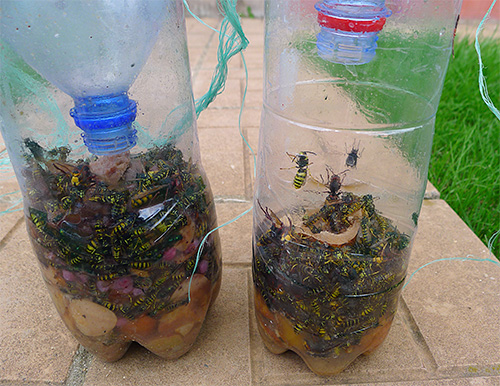
The wasp trap is perhaps the most effective and simplest means of getting rid of insects in the area if their nest itself is located outside of it. Moreover, such traps help not only in the country, in the garden or orchard, but especially in the apiary, where wasps often actively hunt bees. Only a few properly made traps in a relatively short period of time can significantly reduce the number of wasps in the area.
Next, we will look at how you can make a trap for wasps with your own hands, and it will work in such a way that you yourself will be surprised how simple and at the same time very effective the design is. For its production it is enough to have on hand an empty plastic bottle of mineral water, scissors, as well as wire or tape. The very production of a single product will take several minutes on the strength, and such a bottle wasp trap is often even more efficient than expensive store counterparts.

Incidentally, we note that many standard insect traps have virtually no effect on wasps. For example, lamp devices that are very effective against mosquitoes, flies, and night butterflies do not attract wasps at all, and even at a location directly near the vineyard, they catch only insects randomly flying around. A self-made trap, which will be discussed later, first effectively lures wasps (more effectively than, for example, grapes or blackberries on a bush), and then destroys them.
Important!
Even before making a trap for wasps, it will be useful to make sure that the insects did not settle on the site or in the outbuildings by organizing their nest here. To do this, you need to observe where insects fly after feeding on the berries or grapes, and for reliability - carefully check the attic, sheds and sheds. If there is a nest on the plot, it is enough to simply destroy it so that the wasps are no longer disturbed - this will solve the problem in just a couple of hours. However, if you are afraid to come too close to the nest, then the traps will be useful to you in this case as you can by the way ...

Do-it-yourself traps for traps: principles of work and materials used
So now let's take a closer look at how to make a wasp trap with the use of an empty two-liter plastic bottle.
The manufacturing procedure is as follows:
- The upper third of the bottle with the neck is cut off with scissors or a knife.

- The bait is poured into the bottom of the bottle.
- The cover is twisted from the cut part.
- Next, cut off the upper part of the bottle turns the neck down and inserted into the bottom (if the bottle has different diameters at different heights, cut it off so that when turning the upper part becomes the bottom rather tightly).

- Just above the bottom of the neck in the trap, you can additionally make small holes (however, this is not necessary). They are needed so that the smell of the bait leaves the bottle better and spreads around, but the insects themselves should not be able to crawl through these holes.
- If you plan to hang the trap on the branches of trees, in the upper part of the resulting structure from different sides, two holes are made into which a wire loop is inserted - a handle is obtained.
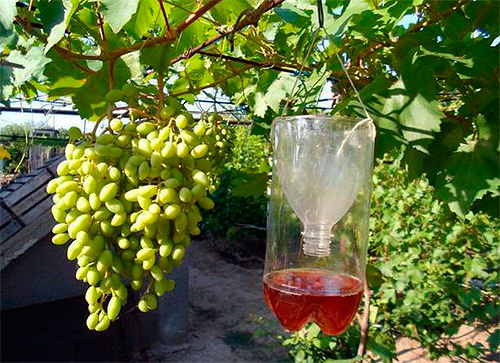
Important!
A bottle size of 2 or 5 liters will be optimal if universal is required. trap from wasps and hornets. The fact is that with a large number of them in one day, several dozens and even hundreds of insects can get into the bottle, so smaller traps simply cannot accommodate such a number of “guests”. If you need a trap only for paper wasps, you can take a bottle and a smaller volume, for example, 1.5 liters.
The principle of the self-made trap is simple: a wasp, attracted by its pleasant aroma, crawls through the funnel into the inside of the bottle, feasts on bait, and then tries to fly out, either instinctively flying up or crawling to the top of the trap along the inner wall. In any case, the insect rests on the junction of the two parts of the bottle and the "biological algorithms" simply do not allow the wasp to make a saving journey along the neck of the funnel to the exit from the trap.
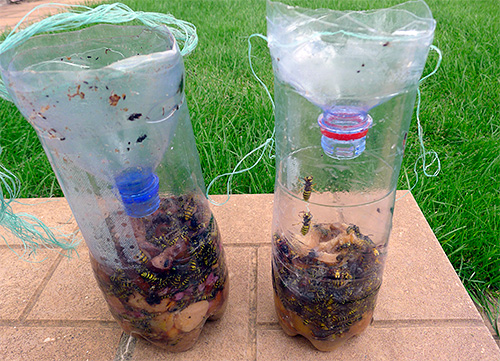
Very often such traps are placed by experienced summer residents under tables on verandas or in summer kitchens, since wasps to tables are strongly attracted by the smells of cooking foods, especially fish. Here the traps are simply attached to the table legs with scotch tape.
Feedback
“In the summer we had to hang up ten traps in the summer, there were so many wasps. They are caught regularly, every day they had to shake out the bottles. True, there were fewer of them only after a week or two, because there were too many of them. But without any chemistry and bites, like others. "
Valentina Petrovna, Kolomyya
It must be borne in mind that one trap for wasps in an apiary or in a large plot (more than 5 acres) will not help. Here you need to use them at least 5-6 pieces, placed evenly over the territory.

However, if you carefully read, making the above construction with your own hands is only part of the task. The modified bottle turns into a trap only after a properly selected effective bait is placed in it, which can attract wasps.
Properly preparing bait for the trap
As bait for wasps and hornets, traps are usually used in braga, kvass, beer (with sugar), fermented jam, diluted with water, honey, watermelon juice or compote. They are poured into a trap so much that some distance remains to the bottom of the neck.
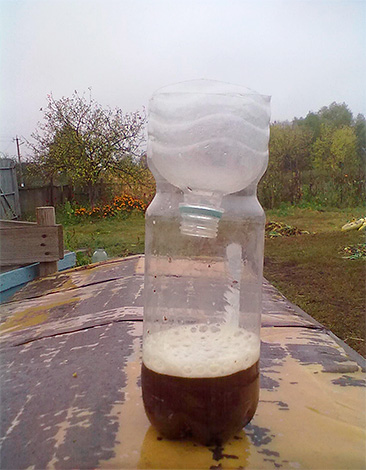
Important!
The choice of bait must be treated very responsibly.It should not attract bees, which are very important for pollination of plants in the garden and in the garden. Therefore, sugar syrups or fresh jam, especially in the apiary, pouring into the trap is undesirable. On the same beer or beer the bees do not fly.
Wasp traps in the country can also be filled with bait with toxic substances. First, even single wasps, which will get out of the trap, after feeding such bait will die. And secondly, even being caught, living wasps were already trapped and would not have been able to calmly shake them out (can you imagine shaking out two hundred still alive wasps). When using the insecticidal additive in the bait, the insects die very quickly, they can be removed, and the trap can be hung out again for work.

Poison bait traps can also be made with your own hands. To do this, standard kvass, beer or compote is added and boric acid is thoroughly mixed, or you can buy effective insecticidal preparations that do not smell, they work even better. These include, for example, Get, Lambda Zone, Delta Zone. These are not very expensive products and will last for a long time.
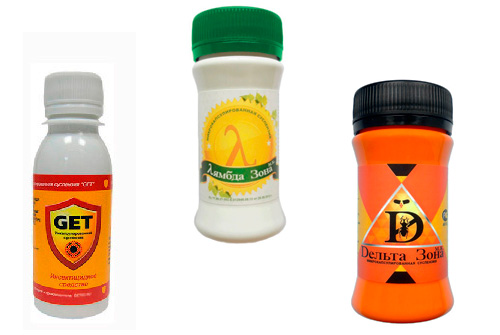
You can also use as a bait special drug Otos.It is implemented in 10-gram packages, and the content of each package is enough for one trap. The powder is simply poured into a bottle and poured with half a glass of warm water, then stirred. After 2-3 hours, the mixture will start to smell and attract wasps, and the bees will not flock to such bait.
Purchased products: types, prices and reviews
If there is no desire to tinker with the manufacture of a wasp trap, then it is quite possible to buy it. For example, the following models are being actively sold in agricultural stores or via the Internet today:
- Wasp Trap is a wide plastic trap with a transparent top and a colored bottom. It has special entrances directed inward and upward, and these entrances turned out to be inside the wasps are no longer found. The Wasp Trap trap has a convenient mount for hanging on the branches, and costs about 400 rubles.

- Swissinno, a Swiss-made trap. It works almost the same as Wasp Trap, but it looks like a neat bucket. Already sold with a bait that does not attract bees. It also costs about 400 rubles.

- GUARD’n CARE Chinese production commissioned by the Dutch concern - a product with several compartments of different widths. It costs about 350 rubles.

All these traps are quite effective, and the price does not reflect their quality. You can buy either the one that is cheaper and easier to deliver, or the one that is available (we recommend to prefer the Swissinno trap).
Feedback
“We suffered from wasps this summer. They made a nest in the fence at the dacha, and my daughter and I arrived a day earlier than my husband. Well, we were bitten the first day. I called my husband, he arrived with a trap. Such a bucket with holes on the sides. Hanged right near the nest, poured there sweet compote. The wasps were caught for several days, until the whole trap was not beaten, but there was no point in that. All the same, the rest flew. It ended with the husband pouring gasoline over their nest at night and burning it. ”
Yana, Kirov
Sticky traps for wasps
Another way to catch wasps in the country is to do it with adhesive tapes designed for flies. Such tapes are hung in places of the largest accumulation of wasps, and sooner or later insects sit down on them to rest, stick and die.


Tapes have their advantages and disadvantages. Their main advantages are low cost, availability and ease of use. Even they do not require bait! But the disadvantages of sticky traps include the fact that not only wasps can stick to them, but also bees, butterflies, horsemen, beetles and a bunch of other, sometimes useful insects. Another disadvantage is that sticky tapes do not particularly attract wasps.
In addition, adhesive tapes should be hung in places that are visible and free from other objects. By themselves, they have an unsightly appearance, and being plastered with wasps, flies and mosquitoes, still stirring, are a frankly repulsive sight. Therefore, in most cases, bottle traps that can be disguised or placed under the table or in the thick foliage are preferable to tapes.
Practice has shown that sticky tapes do not allow efficient catching of hornets: these insects can detach themselves from the velcro, intended, in fact, only to keep flies.

At the apiary to protect the hives, you can use special glue, which is used for catching cockroaches in houses or caterpillars in gardens. Glue is applied in a thin layer on cardboard or a sheet of plywood, and the entire trap is placed on the hive or other prominent place. For reliability inside it you can put a piece of watermelon or peach. In such a mass of glue even the hornet gets stuck.

From os you can use, for example, the following adhesives:
- RaTrap, a tube of 135 ml which costs about 80 rubles.
- Clean House at a price of 60 rubles for 60 grams;
- ALT, about 200 rubles for 135 grams.
For the manufacture of one sticky trap is 100-120 grams of glue.
Important!
At the apiary, you need to carefully monitor that the sticky traps do not come across bees.
Below is a video from Southeast Asia, where a trap with such a principle of action in the apiary is caught giant hornets:
Huge hornets in the apiary caught in a glue trap
What if the OS traps don't help?
In exceptional cases, even with the constant catching of a large number of wasps, their number in the area may not seem to decrease. In such situations, you should either just endure when the grapes or raspberries are gone, or find their nest in the vicinity and destroy it.


In horticultural partnerships with high building density, wasps are almost certainly settled on someone else’s land. Bypassing the neighbors, you can eventually find a "lucky man" who has their nest in the attic or in the toilet, and often several at once. In addition, in apiaries or adjacent to abandoned territories, you can catch a pair of wasps with leather gloves, tie scarlet ribbons around their abdomen, release them and track where they will fly.Just half an hour so you can find their nest.
To learn how to properly destroy the nests of wasps and hornets, read other articles on our website (section "Hornets and wasps"). We also recommend that you familiarize yourself with the useful video below.
Interesting video: making effective traps for wasps from improvised means
And here is another version of a simple OS trap and a vivid example of its work.




Thank! Very helpful)
This is pipets, there is no escape from them at all, just wait for the winter. Flying creatures, the more you kill them, the more they appear.
Also faced the problem of wasps. The nest is located under the roof in a very inaccessible place, it’s reluctant to disassemble, and was even afraid of the angry swarm. Here I hung a couple of stickies, wasps stuck in huge quantities, some fall immobilized into a substituted bucket, but with all this they do not get smaller ... I will try the bottle described by you.
In general, thanks for the article and good luck in the destruction of wasps.
Thanks a lot. I am a beginner woman, the question with wasps is my most painful one!